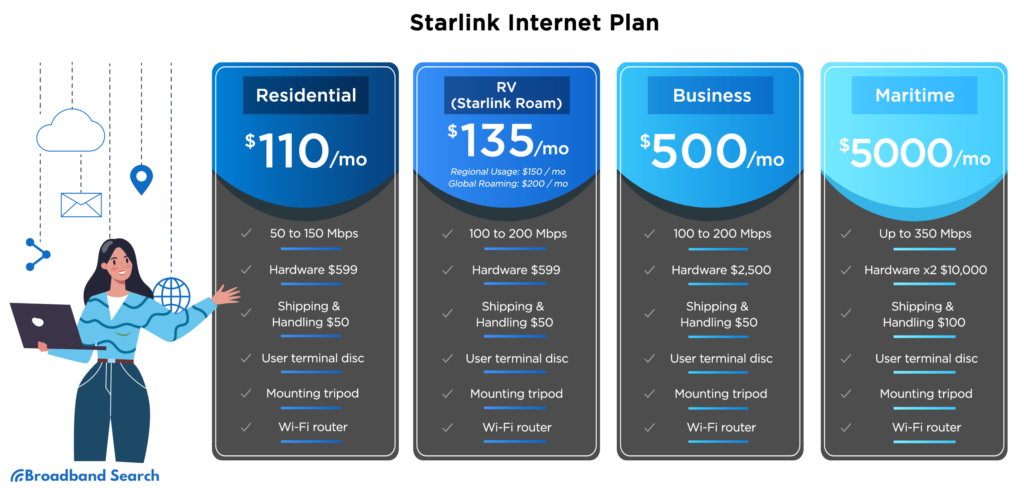
starlink cost
Introduction: What is Starlink, and Why Should You Care About Its Cost?
Starlink is a satellite internet constellation project initiated starlink cost by SpaceX, the private space exploration company founded by Elon Musk. Launched to provide internet connectivity to underserved and remote areas, Starlink aims to bridge the digital divide by offering high-speed broadband service globally. But while its ambitious goals have captured headlines, the question on many people’s minds is: how much does Starlink cost, and is it worth it for the average consumer?
Starlink’s cost structure includes several factors such as the initial equipment fee, monthly service fees, and potential add-ons or maintenance expenses. These costs can vary based on location, equipment needs, and even possible future changes in SpaceX’s pricing strategy. For customers living in rural or remote areas where traditional ISPs (internet service providers) struggle to reach, Starlink’s pricing could represent a breakthrough in accessible internet. However, for others who already have reliable internet options, the cost-benefit equation becomes a bit more nuanced.
In this article, we will dive deep into the different cost starlink costcomponents of Starlink, how they compare to traditional ISPs, what users can expect in terms of long-term expenses, and whether Starlink truly offers value for its price tag. We’ll also explore potential hidden costs, such as performance variability, equipment replacements, and future pricing trends, to give you a comprehensive overview of the financial implications of switching to Starlink.
The Breakdown of Starlink’s Initial Costs: What Do You Pay Upfront?

When you sign up for Starlink, the first cost you’ll encounter is the upfront fee for the equipment. The standard Starlink kit includes a satellite dish (also known as a “Dishy”), a Wi-Fi router, power supply, and mounting tripod. As of 2024, the upfront cost for this kit is set at around $599. This might seem steep compared to the cost of a traditional ISP, where the starlink cost equipment fee is often much lower or included in the service subscription. However, it’s essential to consider that Starlink is a satellite-based system, and its equipment is specifically designed to communicate with satellites orbiting Earth.
One reason for this higher cost is that the technology involved is significantly more advanced than standard cable or fiber-optic setups. The Starlink dish needs to track moving satellites across the sky to maintain a constant internet connection, which requires a more starlink cost complex setup than a traditional ISP modem or router. Installation is usually self-service, meaning you won’t have to pay an additional fee for a professional installer unless you require specialized mounting hardware or assistance. Some users may opt for more complex mounting systems, which could add anywhere from $50 to $150 to their initial expenses.
On top of the equipment cost, there may also be shipping starlink cost fees, which can vary depending on your location. In most cases, users report that shipping can add an additional $50 to $100 to their final bill. Thus, while the advertised price for Starlink’s equipment may be $599, the real initial cost to consumers often falls somewhere between $650 and $750 once all factors are considered.
Starlink Monthly Subscription Fee: How Much Does It Really Cost to Stay Connected?
The second major cost associated with Starlink is its starlink cost monthly subscription fee. As of now, the standard Starlink service costs $120 per month, which places it on the higher end compared to many traditional ISPs, especially for urban areas. However, this cost is relatively competitive for rural areas where satellite or fixed wireless internet services often charge similar rates but offer significantly slower speeds and less reliable connectivity.
Starlink promises download speeds ranging from 50 Mbps to 200 Mbps, depending on network congestion, weather conditions, and other factors. This is more than starlink cost sufficient for most everyday internet activities such as streaming, gaming, video conferencing, and large file downloads. For rural and remote users who have been stuck with sluggish internet speeds from older satellite providers or DSL, Starlink’s price might actually be quite reasonable given the speed increase.
However, it’s important to note that Starlink’s service fee might not remain static. Elon Musk has previously stated that SpaceX intends to lower prices over time as the Starlink network becomes more efficient and costs decrease. This could mean more affordable internet access for customers in the long run, but it also introduces uncertainty about how prices might change for early adopters. Future price changes could either be a pleasant surprise or an unwelcome expense depending on SpaceX’s long-term pricing strategy.
Comparing Starlink’s Cost to Traditional Internet Providers
When evaluating the cost of Starlink, it’s essential to compare it to other internet options currently available. Traditional ISPs such as cable, fiber-optic, and DSL starlink cost providers typically charge much lower monthly fees, ranging from $40 to $100, depending on the speed and service plan. However, these services are often unavailable or unreliable in rural or remote areas, which is where Starlink shines.
Cable and fiber-optic connections offer faster speeds and lower latency than satellite internet, and they often come with bundled services such as TV and phone packages. These providers might also offer promotions, discounts, or equipment subsidies that lower the overall cost. For urban dwellers, these ISPs tend to be a more affordable option. However, the situation changes dramatically in rural areas where the cost of laying fiber or coaxial cables can be prohibitively expensive for ISPs, leading to slower DSL or satellite options.
In such cases, Starlink’s higher upfront and monthly costs may be justified by the significant improvement in internet speeds and reliability. In contrast, in areas where fiber or high-speed cable internet is available, the cost comparison becomes more difficult. Users must decide whether the extra price for Starlink’s low-latency satellite service is worth the potential benefits of mobility, starlink cost uninterrupted service during natural disasters, or possible future price reductions as the technology improves.
Are There Hidden Costs with Starlink? What to Watch Out For
While the basic cost of Starlink is relatively straightforward, there are potential hidden expenses that users should consider. For one, Starlink requires a clear view of the sky, meaning users may need to invest in specific mounting equipment to avoid obstructions such as trees, buildings, or other obstacles. Depending on your location, this could lead to additional expenses, such as mounting poles, roof mounts, or professional installation services, which can cost anywhere from $100 to $500.
Another factor to consider is the cost of potential upgrades. As SpaceX continues to refine and expand the Starlink network, new versions of the equipment might be released. Early adopters may find themselves needing or wanting to upgrade to newer versions of the dish or router to take full advantage of network improvements. While Starlink has not yet charged existing users for upgrades, starlink cost future upgrades may come with a cost.
Additionally, there is always the chance of service starlink cost disruptions caused by technical issues, severe weather conditions, or network congestion. While Starlink generally performs well in most environments, some users report slower speeds or occasional outages during heavy storms or in densely populated areas where network demand is high. These interruptions could potentially lead to additional costs for backup internet solutions, such as mobile hotspots, especially for users who rely on consistent connectivity for work or other essential tasks.
Long-Term Value: Is Starlink Worth the Investment?
For those living in rural or underserved areas, starlink cost Starlink’s cost may be well worth the investment due to the dramatic improvement in speed and reliability compared to existing satellite or DSL options. The convenience of a satellite-based internet solution that doesn’t rely on complex infrastructure, such as fiber cables, can make it a game-changer for many users who have long been limited by geography. However, for urban users who have access to high-speed cable or fiber internet, the long-term value of Starlink becomes more debatable.
One advantage Starlink has over traditional ISPs is its starlink cost flexibility. Since the service is not tied to any particular location, users can take their dish with them if they move, provided they continue to live within Starlink’s coverage area. This makes it an attractive option for digital nomads or individuals who frequently relocate. Additionally, as SpaceX continues to launch more satellites and expand the network, users can expect improvements in speed, reliability, and even pricing over time.
Ultimately, whether Starlink is worth the investment starlink cost depends largely on the user’s specific needs and location. For rural and remote users, the cost may be a small price to pay for high-speed, low-latency internet that was previously unattainable. For urban users, however, the relatively high monthly fees and initial equipment costs may not provide enough of an advantage over existing options to justify making the switch.
Potential Future Costs: What Might Change as Starlink Expands?
Starlink is still a relatively new service, and as it expands, starlink cost there are likely to be changes in its pricing model. SpaceX has been clear that the company intends to drive down costs over time, particularly as it launches more satellites and refines the technology. However, it’s also possible that additional service tiers, premium plans, or specialized offerings (such as enterprise or maritime plans) could introduce higher pricing for specific use cases.
Another potential future cost involves data caps. starlink cost Currently, Starlink does not have strict data limits for its residential plans, but that could change as more users join the network and demand increases. Many traditional ISPs enforce data caps or throttle speeds after a certain amount of data usage, and it’s not out of the question that Starlink could implement similar measures to manage network congestion.
Users should also consider the possibility of future government regulations that could impact the cost of satellite internet. As satellite technology becomes more prevalent, there could be regulatory changes, taxes, or fees that could drive up costs for consumers. These potential changes make it important for users to stay informed and plan for possible future expenses.
Starlink for Businesses: A Different Pricing Model?
While the focus of this article is primarily on residential starlink cost use, it’s worth mentioning that Starlink also offers services geared toward businesses. The Starlink Business plan costs $500 per month and comes with a more robust hardware package priced at around $2,500. This plan is designed to provide higher speeds and greater reliability, making it suitable for businesses that require consistent internet access for large-scale operations, remote workforces, or multiple users.
For businesses located in remote areas, this could be a starlink cost game-changer, providing them with internet speeds that are on par with urban areas. However, the significantly higher upfront and monthly costs may make it a less attractive option for small businesses or startups that are operating on a tight budget. As Starlink expands its services and network, it’s possible that more business-friendly pricing models could emerge, but for now, the cost remains quite steep for most small enterprises.
Conclusion: Is Starlink’s Cost Justified for You?
Starlink represents an exciting new frontier in internet connectivity, particularly for rural and remote users who have long been underserved by traditional ISPs. While the initial costs may seem high, the potential benefits in terms of speed, reliability, and flexibility make it an attractive option for many. However, for users in urban areas where fiber and cable internet are readily available, the cost-benefit analysis is a bit more complex.
Ultimately, the decision to invest in Starlink depends on your starlink cost specific internet needs, location, and long-term expectations for the service. If you live in a remote area where other options are limited, Starlink could be a revolutionary solution. But if you already have access to affordable high-speed internet, the additional costs may not be worth the switch—at least not yet.
As Starlink continues to grow and expand its services, we can expect further changes in both pricing and performance. Whether you’re an early adopter or considering a future investment, keeping an eye on how the service evolves will be key to determining whether Starlink’s cost is justified for your particular situation.





